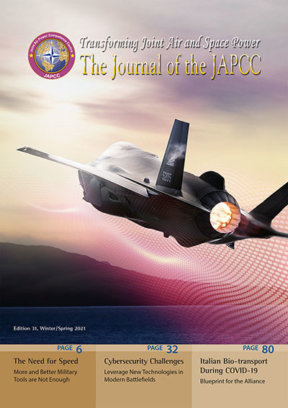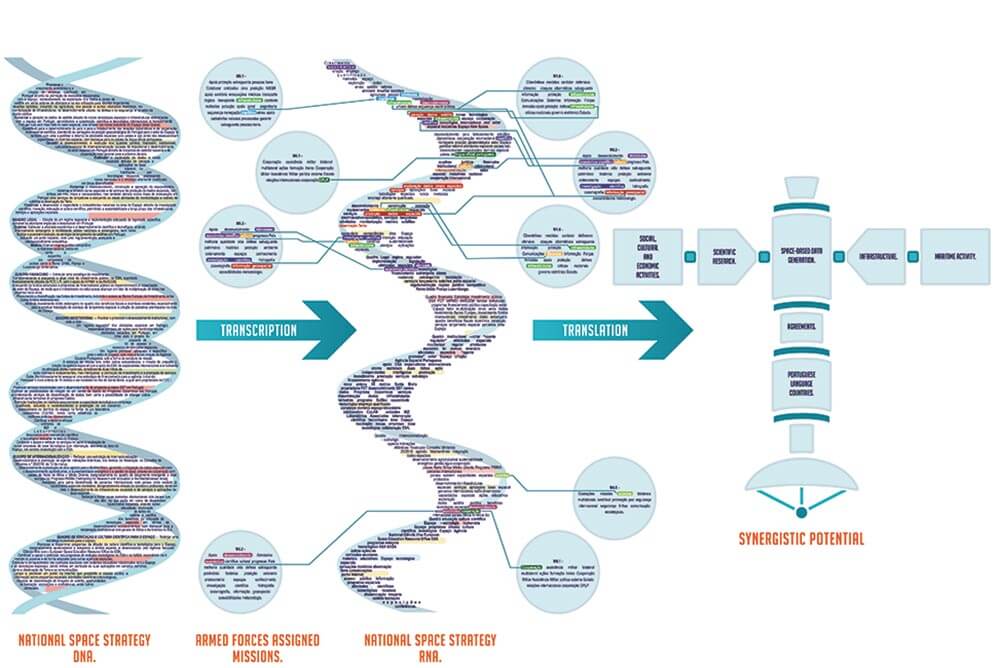Introduction
Space is critical for societal activities and military operations. Inferring from this axiom one can state that ceasing access to space and space data will severely disrupt normality. This highlights the importance of the subject and identifies the need for coherent, thoroughly reasoned and oriented action. Portugal has done just that by constructing a National Space Strategy (NSS), known as ‘Portugal Space 2030’, setting in the form of governmental resolution the ambition, vision and goals for the space sector for the next ten years, leading inter-ministerial efforts towards economic development, job growth and innovation in this area. At a time characterized by the advent of the New Space industry, the very own concepts of Security and Defence evolve when confronted with boundless threats and uncertain risks, with the potential to impact every sector of society, thus requiring a well synchronized whole-of-government approach to tackle this challenge. One of the required steps to achieve this desideratum is the establishment of a more security-oriented complement to the overarching NSS, more specifically in the form of a National Defence guidance. This article intends to provide insights on what the end-state should be and how to pursue it, following the vision of a well-integrated action from civil, commercial and security space participants, reminiscent of a truly symbiotic interaction.
Proposed End-State
Building on the understanding that strategy ‘provides direction for the state, seeking to maximize positive outcomes and minimize negative outcomes, as the state moves through a complex and rapidly changing environment into the future’1 hints that the strategic space environment, seen as competitive, congested and contested, is leading the need to shape the future to meet National Interests. As the desired end-state clearly defined on the NSS is focused mainly on the economic development of the space sector, the reliance on space for military operations and emergency response structures, call for a security-oriented end-state. Beyond this vulnerable reliance, the official recognition of space as an operational domain represents an added responsibility for NATO members to contribute for the overall effort that intertwines the Alliance resolve. Surmounting this political-military commitment, the competition continuum multiplied by the fast-paced technological development has driven an aspiration to effectively harness a Joint All Domain concept of operations, where flawlessly synchronized effects are attained across domains regardless of traditional Service or Branch expertise. This duality of necessities, both in military diplomacy and operational requirements, emerge from a threat analysis where state and non-state actors reveal growing capability on the counter space continuum.2 Deriving from this context, and to properly balance ways and means, a generic end-state, to be pursued by the National Defence Space effort, is proposed: ensure continuous access to space and space-generated data to permanently support combat operations, emergency situations and peacetime mission requirements, across the entire Area of National Strategic Interest, based on a resilient, redundant, regenerative and connectable space infrastructure.
Baseline Research
The research on NSS and the Portuguese Armed Forces3 started by analysing the strategic space process of the United States of America and the United Kingdom (UK), to realize that, in both cases, it is composed by several documents that follow a hierarchical, well-defined and complementary logic between participants from the civil, commercial and security space sectors, harmonizing efforts around the National Interests in the space domain. Interestingly, the analysis of the UK process, where space has been designated a Critical National Infrastructure, pointed out the close link between space and cyberspace domains, in both the organizational steps followed to build new-domain capabilities and the technological interdependency.4 After the analysis of the strategic framework in both case studies, the research proceeded to identify the existing connections to the armed forces by referring to the fundamental concepts military, armed forces and joint force found within the documents of reference on space-related context. This layer pointed out elements such as vulnerability, assets, reliance, human resources, cooperation, resiliency and degraded operational environment, fitting in the structural, operational and genetic aspects of strategy.
The next research step was to adopt the same approach to the incipient Portuguese space strategic process. Parsing through the NSS and the Portuguese Space Agency Business and Installation Plan, the only existing sources available for analysis, leads to the conclusion that none of the key concepts were present at all. Such findings warranted a different approach, one that could assess the compatibility between the NSS and the armed forces. To accomplish that, an analogy to the molecular biology processes of transcription5 and translation6 was sought and applied in practical terms to the text processing of the NSS and the Portuguese Armed Forces Mission Statement, constructing the ideation of, based on the interlinked concepts, the current definition of what the armed forces execute can potentially produce an outcome embedded in the NSS, labelled synergistic potential. This abstract conceptualization is captured in Figure 1.
Figure 1: Synergistic Potential between the NSS and the Portuguese Armed Forces (Design by Alex Curiel). © 99designs
Synergistic Potential
Picking up on the synergistic potential identified at the fundamental levels of both the NSS and the Armed Forces Mission Statement, the following discussion aims at turning the abstract exercise into tangible, realistic terms by highlighting some of the current initiatives and projects that could be leveraged by Defence, while bringing benefits in the form of capability. This is not meant to be an all-encompassing list but rather a starting point to build from and simultaneously address the technological challenges that will define future space developments.
Infrastructure
One of the flagship projects of the Portuguese Space endeavour is the Atlantic International Satellite Launch Programme, with the objective of designing, installing and operating a spaceport on the island of Santa Maria, in the Azores. The goal of this initiative is to start sustainable small-satellite launch services by 2021, taking advantage of the privileged location of the Azores to explore unobstructed, over the water, launch trajectories for Low Earth Orbits (LEO), specifically Polar Orbits and Sun-Synchronous Orbits (SSO). This type of facility can ensure continuous access to Space and incorporate the concept of Operational Response Launch7 , with high-readiness times focused mainly on Intelligence, Surveillance, and Reconnaissance satellites carrying tailored sensor payloads, contributing to the redundant and regenerative aspects of the integrated space infrastructure.
Agreements
The establishment of agreements on a space context has been conducted separately by Defence and civil entities, mainly through the Ministry of Defence and the Portuguese Space Agency. But why not merge and broaden the spectrum of activities, designed jointly from the start? This approach will allow a comprehensive understanding and creation of expertise in this field – a necessary condition to navigate the range of European mechanisms and programs8 available, reinforcing the Portuguese Space contributions through internal cooperation.
Maritime Activity
With the long-awaited extension of the Continental Shelf9, Portugal will have increased responsibility for a substantial part of the Atlantic. This challenge requires extended range and depth for current Defence activities, calling for new ways to monitor surface and subsurface persistently. This might be achieved by fusing data from Manned-Unmanned Teamed Systems, both aerial and maritime, connected by a space structure that enables a timely decision-making process.
This requisite demands higher bandwidth availability from communication satellites, a quest that might be revolutionized by photonic-aided receiver payload on phased array antennas, implementing optical beamforming networks.10
Development of Social, Cultural and Economic Activities
Artificial Intelligence (AI) Moonshot is an ongoing open-challenge that invites everyone to create solutions to identify and track Ocean plastic through the use of AI. This approach to deal with an increasing Environmental issue, resembling the successful Defense Advanced Research Projects Agency Grand Challenge format, has the potential to bring together highly qualified participants with diversified backgrounds, voluntarily working on complex problems that often result in disruptive concepts. Beyond this creative ensemble, the format fosters a community that will stay connected in intensive social dynamic, with the potential to influence cultural evolution and opening new economic activities, as it happened with Autonomous Driving.11 This might be the most intangible benefit, but potentially, the most impactful, not only at a technological level where AI will play a role in several levels, such as payload and orbit optimization but also at a moment when the armed forces struggle with recruitment and retention issues, appealing to a young space generation seems a valid option.
Scientific Research
The technological space evolution has been powered by scientific research and will continue to require scientific breakthroughs to progress. The armed forces, mainly through the Service Academies’ research programs, have the necessary conditions to contribute actively in this field. For this purpose, two vectors must be aligned. First, setting guidance for research development focused on (1) payload technology that supports military activities, such as electro-optical, Synthetic Aperture Radar and Signals sensors; (2) satellite communication technology, looking at the integration with the 5G ecosystem and the required Software Defined Networking and Functions Virtualization architecture that will enable the use of space as a backhaul for 5G12 ; and (3) encryption, mainly through the development of Quantum Key Distribution protocols that will define secure communications standards in the near future.13 Secondly, by educating Defence personnel in this subject, becoming familiar with concepts and language that allow cooperation with civil and commercial partners for quick and effective technology transfer, similarly to the approach established in the International Space University.14
Space-based Data Generation
Defence is leading the national participation on the European Union Space Surveillance and Tracking programme that will soon have sensors and an operations centre implemented at the islands of Madeira and the Azores. This capability will undoubtedly contribute to an increased Space Situational Awareness and also increment Space Safety. But it must not stop here. This initiative can be the ground segment starting point for a more ambitious commitment with the development of an orbital segment that allows the generation of data, essential for several other mission areas such as Space Weather, Space Traffic Management and Shared Early Warning. It is crucial that the initial infrastructure design accounts for connectivity with other partners and also future growth potential.
Portuguese Language Countries
Portugal holds a historical, cultural and emotional link with all the Portuguese language speaking countries, a heritage that has evolved along the centuries and manifests across society. One of the strongest bonds has been guarded by the military institutions from all the countries, formally represented in the Community of Portuguese Language Countries, and becomes visible through permanent staff, operational and academic exchanges, and technical military cooperation. Using this established and trustworthy framework might very well be the most effective way to increase the development of the space sector within a very relevant and broad community, whose member states span the entire Atlantic.
Conclusion
The necessity to benefit society from space, where Defence activities are paramount to provide Security, is uncontested. The vision discussed demonstrates the potential to align Defence efforts to the overarching NSS and avoid excessive branching or duplication of resources. From a wide range of opportunities, it ought to be in synchrony with the overall end-state implicit on the NSS that Defence must act as a catalyst agent. This posture observes the principle of complementarity, contributing actively towards the achievement of the National global objectives, by aligning the compatible/common categories and realizing synergies from that connection. It does not mean pursuing the same outcomes: it translates into coupling technological and organizational assets when required to establish Defence Space capability to support combat operations, emergency situations and peacetime mission requirements, but seeking alternatives means when dual-use is not feasible. A critical key to success in this regard, adding up to the required financial investments, is the need for skilled human resources able to bridge across all space sector participants, creating solutions for the non-linear problems presented on this uncharted system, supported by leadership with enough organizational backpedal to accept risk and learn from failure.15












